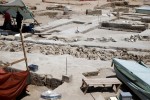 Archaeologists excavating the Falyron Delta necropolis in Athens, Greece, have unearthed two mass graves containing the skeletal remains of 80 people, some with iron shackles still clamped to their wrists. In one mass grave, the bodies had been laid carefully side by side in a long line. In the other, they were more haphazardly tossed into the pit, their skeletons found one on top of the other. Analysis of the teeth indicates these are the remains of young, healthy men.
Archaeologists excavating the Falyron Delta necropolis in Athens, Greece, have unearthed two mass graves containing the skeletal remains of 80 people, some with iron shackles still clamped to their wrists. In one mass grave, the bodies had been laid carefully side by side in a long line. In the other, they were more haphazardly tossed into the pit, their skeletons found one on top of the other. Analysis of the teeth indicates these are the remains of young, healthy men.
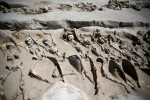 The cemetery was in use from the 8th to the 5th century B.C., and two small vases found in the mass graves date to between 675 and 650 B.C., a time when the city was in the grip of series of political crises. Archaeologists speculate that the young men were executed during one of those crises.
The cemetery was in use from the 8th to the 5th century B.C., and two small vases found in the mass graves date to between 675 and 650 B.C., a time when the city was in the grip of series of political crises. Archaeologists speculate that the young men were executed during one of those crises.
“They have been executed, all in the same manner. But they have been buried with respect,” Dr. Stella Chryssoulaki, head of excavations, said.
“They are all tied at the hands with handcuffs and most of them are very, very young and in a very good state of health when they were executed.”
The experts hope DNA testing and research by anthropologists will uncover exactly how the rows of people died. Whatever happened was violent — most had their arms bound above their heads, the wrists tied together.
But the orderly way they have been buried suggest these were more than slaves or common criminals.
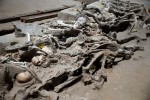 One possibility the archaeologists are batting around is that these might have been the supporters of a failed would-be tyrant named Cylon. In 632 B.C., Cylon, an Athenian aristocrat and champion of the double-stadion race (ca. 400 meters) at the 640 B.C. Olympic Games attempted to take Athens with the backing of his father-in-law, Theagenes, tyrant of Megara. He had consulted the Oracle of Delphi and Apollo’s mouthpiece assured him that he should conquer the citadel of Athens during a festival of Zeus. Prophecies are tricksy things, though, and the ancient sources report that he picked the wrong festival and he and his select cadre of noble young fighters met unexpected resistance. With their coup attempt quickly defeated, Cylon and his supporters took sanctuary near the statue of the goddess in the temple of Athena on the Acropolis. Cylon and his brother managed to sneak out, but the rest of his followers were stuck in the temple.
One possibility the archaeologists are batting around is that these might have been the supporters of a failed would-be tyrant named Cylon. In 632 B.C., Cylon, an Athenian aristocrat and champion of the double-stadion race (ca. 400 meters) at the 640 B.C. Olympic Games attempted to take Athens with the backing of his father-in-law, Theagenes, tyrant of Megara. He had consulted the Oracle of Delphi and Apollo’s mouthpiece assured him that he should conquer the citadel of Athens during a festival of Zeus. Prophecies are tricksy things, though, and the ancient sources report that he picked the wrong festival and he and his select cadre of noble young fighters met unexpected resistance. With their coup attempt quickly defeated, Cylon and his supporters took sanctuary near the statue of the goddess in the temple of Athena on the Acropolis. Cylon and his brother managed to sneak out, but the rest of his followers were stuck in the temple.
Thucydides describes the result of the failed coup in his History of the Peloponnesian War (1.126).
Now those that were besieged with Cylon were for want of both victual and water in very evil estate, and therefore Cylon and a brother of his fled privily out; but the rest, when they were pressed and some of them dead with famine, sat down as suppliants by the altar that is in the citadel. And the Athenians, to whose charge was committed the guard of the place, raising them upon promise to do them no harm, put them all to the sword. Also they had put to death some of those that had taken sanctuary at the altars of the severe goddesses as they were going away.
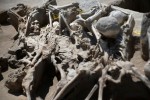 The killing of suppliants was considered a profane act, a sacrilege that would take generations to expiate. The archon Megacles, who ordered the executions, and his extended family, the Alcmaeonidae, were exiled from Athens and cursed with a miasma, a “stain” that would taint the Alcmaeonidae for generations even after the archon Solon allowed them to return to Athens in 594 B.C. Pericles, the great statesman and general of Athens, was Alcmaeonid on his mother’s side and the miasma still caused him political trouble well into the 5th century.
The killing of suppliants was considered a profane act, a sacrilege that would take generations to expiate. The archon Megacles, who ordered the executions, and his extended family, the Alcmaeonidae, were exiled from Athens and cursed with a miasma, a “stain” that would taint the Alcmaeonidae for generations even after the archon Solon allowed them to return to Athens in 594 B.C. Pericles, the great statesman and general of Athens, was Alcmaeonid on his mother’s side and the miasma still caused him political trouble well into the 5th century.
If archaeologists are able to successfully extract DNA from the remains, it’s possible they may be able to help narrow down who they were, although I seriously doubt they can pinpoint participants in the Cylonian Affair. Best case scenario they figure out the method of execution, probably through osteological analysis. They didn’t die in a plague, that’s for sure, and there’s no way of doing any kind of kinship analysis, so I don’t see how DNA can link them to Cylon.
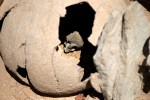 More than 1,500 bodies were buried in the Falyron Delta necropolis during its centuries of use. It was the cemetery for regular people; Athens’ rich and famous were buried in the Kerameikos cemetery. Now part of a vast park in the shadow of the new opera house and library between downtown Athens and the port of Piraeus, the necropolis continues to be excavated. Chryssoulaki hopes it will eventually become an open-air museum.
More than 1,500 bodies were buried in the Falyron Delta necropolis during its centuries of use. It was the cemetery for regular people; Athens’ rich and famous were buried in the Kerameikos cemetery. Now part of a vast park in the shadow of the new opera house and library between downtown Athens and the port of Piraeus, the necropolis continues to be excavated. Chryssoulaki hopes it will eventually become an open-air museum.
“They were found earlier this year in part of the Falyron Delta necropolis – a large ancient cemetery unearthed during the construction of a national opera house and library between downtown Athens and the port of Piraeus.”
Presumably, that opera house is the “Stavros Niarchos Foundation Cultural Center” at 37 56 23 N , 23 41 30 E , i.e. near Φάληρον, Phálēron or “Phalerum”, also referred to as “Palaio Faliro” (Old Phaleron), the ancient city port. However, “Falyron” looks incorrectly rendered to my unskilled eye.
I’ve read about this interesting find about half a year ago on a Greek news site (presumably in English), which I THOUGHT I had bookmarked (I had found it by accident …and now cannot find it any more, …of curse for rypherence).
Those pictures of the skeletons are really disturbing. A lot of them have their mouths open really wide, like they were screaming or something when they died 🙁
More recently they used to bind the jaws of the deceased with strips of fabric shut so that as they decomposed their mouths would stay shut and not look so gruesome at funerals. The decomposition gasses pop mouths open so that would likely be the cause.(If you are a specialist in this, and the article I read was incorrect please correct me, thanks)
Yes, the “Stavros Niarchos Foundation Cultural Center” (SNFCC). The article that I saw earlier this year could have been the 2nd one from the list below.
BTW, just in case the plotters from last month in Turkey are ‘accounted for’ and ‘still alive’, their whereabouts should be given notice of, shouldn’t they ?
http://www.naftemporiki.gr/story/1093691/necropolis-with-80-skeletons-of-executed-men-discovered-possibly-linked-to-ancient-athenian-coup
http://www.ekathimerini.com/207941/gallery/ekathimerini/life/ancient-mass-graves-found-in-athens-seen-as-significant-discovery
http://greece.greekreporter.com/2016/03/26/shackled-skeletons-might-tell-story-of-rise-of-ancient-athens/
If some of the DNA comes from elsewhere (across the Mediterranean or modern Turkey for example) that also might help narrow it down. Sadly, the Ancient Greeks not only had trouble with other Greeks, but they also had problems with the rest of the world.
Cylons always causing trouble!! 😆
Well yes but it wouldn’t open the mouth that much. I believe that the ‘screaming faces’ are merely the result of decomposition of the muscles around the jaw which makes the mandible come loose. Awesome find btw!
Oh I actually meant to post this as a reply to RMW
You see that a lot and no it’s not some last moment horror gasp as bait-click websites would have you believe. Facial distortions/mouths open…etc usually part of the decomposition process as explained above.
Democracies are born from violence, and they are killed by violence. There’s a lot we don’t know about the Archons, but given that Athens made it through the Greek Dark Ages as Ionian and managed to colonize places as far as Spain by 700 BCE, the Archons must have been widely revered for a long time. Rebelling against the Archons would have been like picking a fight with a god.
that’s too funny
The jaw would be free to drop like that (post-mortem, of course) only if the head were not buried. Otherwise soil or debris would hold the mouth closed, as clearly shown in other skeletons in that same article. So maybe the bodies were left on display? That would be a horrible (and disgustingly smelly) sight, but perhaps for the edification and enrichment of the populace? Simpler than impalement or crucifixion, I’d say. But who would leave shackles (presumably, given the article and the iron stains around many of the elevated hands) lying about in a grave? Those things are expensive!
Their were very young people according to complete tooth.
Well, they might have left the bodies exposed until the shackles were too icky, before they self-cleaned with time.
The pots are dated 650-25, not 675-50—the press apparently misunderstood which period was the 3rd quarter of the 7th century. The 650-25 dating is important because it gives a context for the mass-graves that agrees with the suggestion that the corpses are the victims of the aftermath of Cylon’s conspiracy. See https://www.forbes.com/sites/kristinakillgrove/2016/04/15/what-is-the-real-date-of-cylons-murdered-conspirators-from-ancient-greece/